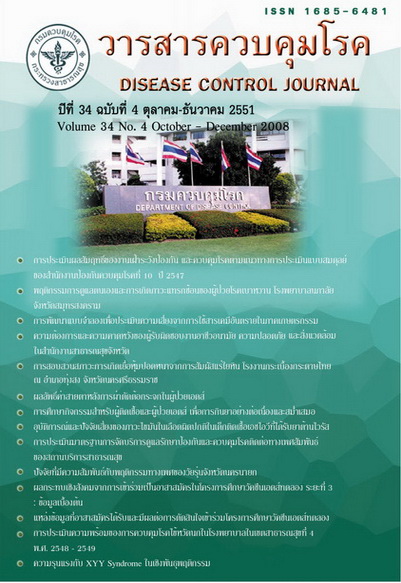Behavioural Genetics in Violence and XYY Syndrome
Keywords:
Violence Behavioral Genetics, Genes, XYY syndromeAbstract
Nowadays, violence was one of the most important problems in Thailand. It was the early causes of death people after road traffic injury of many years. With modern technology, we had known that environment influencing different kinds of behaviors, but the most significant factors was Gene. Many researches found that violent behaviors, either suicide or alcoholic consumption tied to genes. Genes worked together with environment and controled our behavior. The most influential violent gene was Monoamine Oxidase (MAOA). The research revealed that if enzyme which constructed from this gene had low activity, the person would have trend to be violence than normal. According to MAOA gene that located on chromosome X (Xp11.23-11.4), had more opportunity to deficient this gene and caused men establish violent behavior more than women. Anyway, the XYY syndrome was one type of sex chromosome abnormality (aneuploidy type) which liked crime behavior. Man who had this karyotype was always taller than normal man. During childhood, they had late development in communication and reading. However, when they grew in adulthoods, they usually looked like normal persons. The most interesting point was most criminals, which had been diagnosed their karyotype, were belonging to XYY genotype. Thus karyotyping diagnosis of new born baby and criminals were useful in kind of violent protection in the future.
Downloads
References
2. Bohman M, Cloninger R, Knorring ALV. The genetics of alcoholisms and related disorders. J. of Psychia. Res. 1987; 21(4): 447-52.
3. Bellivier F, Sz?ke A, Henry C, Lacoste J, Bottos C, Bertrand MN, et al. Possible Association between Serotonin Transporter Gene Polymorphism and Violent Suicidal Behavior in Mood Disorders. Biol. Psychia. 2000; 48: 319-22.
4. Caspi A, McClay J, Moffitt TE, Mill J, Martin J, Craig IW, et al. Role of Genotype in the Cycle of Violence in Maltreated Children. Science 2002; 297: 851-4
5. Stokstad E. Violent Effects of Abuse Tied to Gene. Science 2002; 297: 752.
6. Human Genetics Alert. Genetics and Violence [Online]. Available from: http://www.hgalert.org/topics/behave Genetics/geneticsviolence.html [Accessed 2007 May 14]
7. Amar P. Genetic basis for Violence [Online]. 2004. Available from: http://serendip.brynmawr.edu/bb/neuro/neuro04/ web2/apatel.html [Accessed 2007 Oct 30]
8. The Turner Center. XYY males: An orientation [Online]. Available from: http://www.aaa.dk/TURNER/ENGELSK/ XYY.HTM [Accessed 2007 Oct 19]
9. Stoll C, Flori E, Clavert A, Beshara D, Buck P. Abnormal children of a 47, XYY father. J. Med. Genet. 1979; 16(1): 66-8
10. อมรา คัมภิรานนท์. พันธุศาสตร์มนุษย์. กรุงเทพฯ: บริษัทเท็กซ์แอนด์เจอร์นัลพับลิเคชั่นจำกัด; 2542
11. Genes and You- Teaching about Genetics from a Human Perspective. Unit 7: Blame it on your genes [Online]. 2004-5. Available from: http://www.gig.org.uk/ genesandyouunitseven.htm [Accessed 2007 Oct 30]
12. Shirley R. Long term outcome in children of sex chromosome abnormalities. Arch. Dis. Child. 1999; 80: 192-5.
13. สุชิลา ศริทิพยวรรณ และ พัลลภ พงษ์สุทธิรักษ์. การเจาะถุงน้ำคร่ำในไตรมาสที่สองเพื่อตรวจโครโมโซมทารก: การศึกษาในหญิงตั้งครรภ์ 1,213 ราย. พุทธชินราชเวชสาร 2548; 22(3): 321-8.
Downloads
Published
How to Cite
Issue
Section
License
Articles published in the Disease Control Journal are considered as academic work, research or analysis of the personal opinion of the authors, not the opinion of the Thailand Department of Disease Control or editorial team. The authors must be responsible for their articles.






